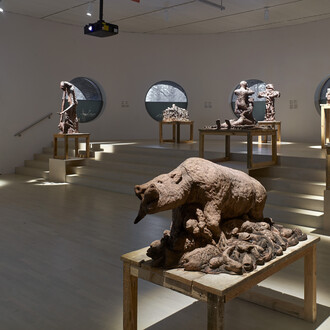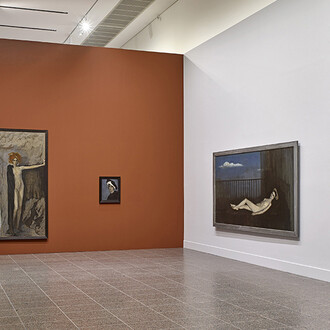In art history, the concept of “living sculptures” is associated with the UK-based art personalities Gilbert & George. The duo, who claim to be “two people, but one artist,” (1) revolutionized art in the late 1960s by declaring themselves to be a living sculpture.(2) “Art and life became one, and we were the messengers of a new vision. At that moment that we decided we are art and life, every conversation with people became art, and still is.”(3) This anomalous attitude broadened the concept of sculpture in the context of the then emerging conceptual art movement and caused a stir – not least among the informed circles of the European art scene.
Gilbert & George’s ideas had a special impact in the German Rhineland, where the close-knit artists Konrad Lueg, Sigmar Polke, and Gerhard Richter had been looking for new ways of making art both individually and collectively since the early 1960s. As a result, the three didn’t just work in the medium of painting, but also experimented with works that approached the genre of sculpture in different forms – an additional parallel to their London-based colleagues. And thus Lueg, who became Gilbert & George’s gallerist in 1969/70 (4) under the name Konrad Fischer, dealt with this set of issues in many forms.
The beginning of this examination was marked by two papier-mâché figures in 1963 depicting Düsseldorf gallery owner Alfred Schmela and American President John F. Kennedy. (5) These works, which Lueg realized in collaboration with Gerhard Richter, were part of the action Leben mit Pop – eine Demonstration für den kapitalistischen Realismus/Living With Pop – A Demonstration for Capitalist Realism and reflected the virulence of the Fluxus phenomenon as well as that of Pop Art. (6) A short time later, Lueg produced a larger number of sign-like objects depicting women, boxers, or football players that sit on the boundary between sculpture and painting. In 1967 he started to expand the spectrum of his sculptures to include both small and large inflatable cubes made of shower curtain-like plastic film. With their patterns and voluminous forms, these works can be read as a response to American Minimal Art but are also characterized by a sense of humor that resonates with Gilbert & George’s works As Used by the Sculptors (1972) or Reclining Drunk (1973).
Polke's fascination with sculpture can be understood even more clearly as he produced – or ordered the production of – a whole series of objects and installations. Kartoffelhaus/Potato House (1967) can be cited in this context, as can Polke’s Peitsche/The Whip (1968) or the so-called potato machine, Apparat, mit dem eine Kartoffel eine andere umkreisen kann/Apparatus Whereby One Potato Can Orbit Another (1969). Polke’s drawings also act as the basis for the ideation of sculptural works, whereby the majority of the sketches were not realized as objects. At the same time, Polke planned a series of objects that he did eventually use as staffage for photographs or films. It is precisely these works, which also include the 1968 portfolio …höhere Wesen befehlen/Higher Beings Ordain, that are closely connected with performative actions and build another conceptual bridge to Gilbert & George’s approach.
Richter, on the other hand, only produced object-like works again years later in the course of rather experimental joint work with Konrad Lueg; first in 1969 with 4 Glasscheiben/4 Panes of Glass, which was followed in 1969/70 by Kugelobjekt/Spherical Object and then in 1971 with Zwei Skulpturen für einen Raum von Palermo/Two Sculptures for a Room by Palermo. Richter's drawings also contain representations that suggest an interest in sculptural expression and installation. One example is the 1968 draft for Zwölf Röhren/Twelve Tubes, which Richter realized that same year. (7) In addition to an open mind for testing out works that can be seen as existing beyond a classical canvas, he has another thing in common with Gilbert & George: an affinity for romanticism, as the duo have produced countless drawings, photographs, and postcards referring to this art-historical epoch.
A shared interest in alternative forms of expression and a closeness of thought meant that Gilbert & George’s art fell on decidedly fertile ground in the Rhineland, which was reflected not least in a lively exchange between the artists mentioned here. Richter made paintings referring to the duo while Polke took photos of them that he colored by hand and Konrad Lueg invited them to create a contribution for an edition.
The exhibition Living Sculptures aims to present Gilbert & George, Konrad Lueg, Sigmar Polke, and Gerhard Richter’s little-known yet still influential encounters with the medium of sculpture while also highlighting the similarities, the differences, and the prolific dialog between these artistic positions.
















